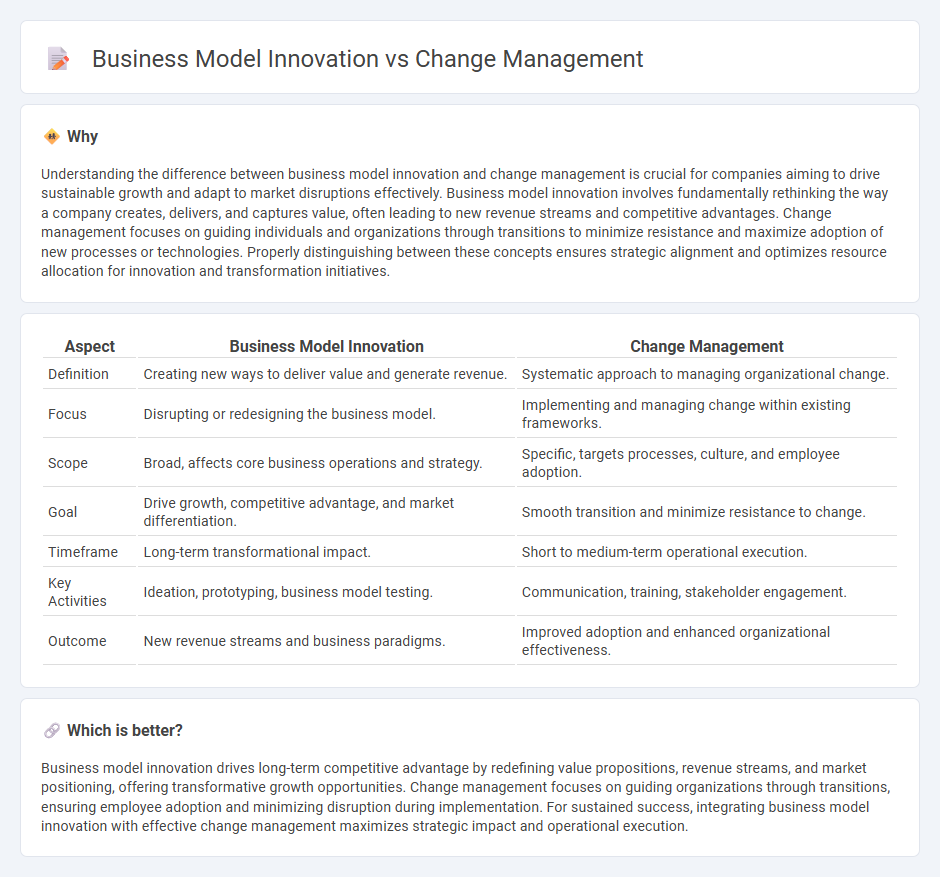
Business model innovation focuses on creating novel value propositions and revenue streams by fundamentally redesigning how a company operates and delivers value to customers. Change management emphasizes guiding individuals and organizations through transitions, ensuring adoption and minimizing resistance during strategic shifts. Explore how combining both approaches can drive sustainable growth and competitive advantage.
Why it is important
Understanding the difference between business model innovation and change management is crucial for companies aiming to drive sustainable growth and adapt to market disruptions effectively. Business model innovation involves fundamentally rethinking the way a company creates, delivers, and captures value, often leading to new revenue streams and competitive advantages. Change management focuses on guiding individuals and organizations through transitions to minimize resistance and maximize adoption of new processes or technologies. Properly distinguishing between these concepts ensures strategic alignment and optimizes resource allocation for innovation and transformation initiatives.
Comparison Table
| Aspect | Business Model Innovation | Change Management |
|---|---|---|
| Definition | Creating new ways to deliver value and generate revenue. | Systematic approach to managing organizational change. |
| Focus | Disrupting or redesigning the business model. | Implementing and managing change within existing frameworks. |
| Scope | Broad, affects core business operations and strategy. | Specific, targets processes, culture, and employee adoption. |
| Goal | Drive growth, competitive advantage, and market differentiation. | Smooth transition and minimize resistance to change. |
| Timeframe | Long-term transformational impact. | Short to medium-term operational execution. |
| Key Activities | Ideation, prototyping, business model testing. | Communication, training, stakeholder engagement. |
| Outcome | New revenue streams and business paradigms. | Improved adoption and enhanced organizational effectiveness. |
Which is better?
Business model innovation drives long-term competitive advantage by redefining value propositions, revenue streams, and market positioning, offering transformative growth opportunities. Change management focuses on guiding organizations through transitions, ensuring employee adoption and minimizing disruption during implementation. For sustained success, integrating business model innovation with effective change management maximizes strategic impact and operational execution.
Connection
Business model innovation and change management are intrinsically connected as successful innovation requires structured approaches to transition and adoption within organizations. Effective change management facilitates alignment of stakeholders, mitigates resistance, and ensures that new business models are integrated seamlessly into operations. This synergy enhances organizational agility, driving sustained competitive advantage and long-term growth.
Key Terms
**Change Management:**
Change management involves structured approaches to transitioning individuals, teams, and organizations from current to desired states with minimal resistance and maximum engagement. It focuses on process improvements, employee adoption, and communication strategies to navigate organizational change effectively. Explore our detailed insights to understand how change management drives successful transformations.
Stakeholder Engagement
Change management emphasizes structured approaches to help stakeholders adapt to organizational changes, ensuring effective communication and participation throughout the transition process. Business model innovation involves redefining value propositions, customer segments, and revenue streams, requiring deeper stakeholder engagement to co-create and validate new business paradigms. Explore effective strategies to enhance stakeholder involvement in both change management and business model innovation initiatives.
Communication Strategy
Effective change management leverages a comprehensive communication strategy to align stakeholders, minimize resistance, and ensure smooth transitions during organizational shifts. Business model innovation communication emphasizes articulating new value propositions and market approaches to internal teams and external partners for successful adoption. Explore how tailored communication strategies drive both change management and business model innovation to maximize impact.
Source and External Links
The 10 Best Organizational Change Management Strategies - Change management is a structured approach to transition individuals and organizations to a desired future state, focusing on minimizing resistance, maximizing engagement, and aligning efforts to achieve specific outcomes through planning, communication, and employee participation.
What is Change Management? Definition & Process - Change management is a coordinated approach that includes defining a clear vision and objectives, providing training and support, managing resistance, and monitoring to sustain changes within an organization through systematic steps like initiating the process and crafting a comprehensive strategy.
What is Change Management? - Change management ensures effective communication and support during organizational changes such as mergers or new technology implementation, involving structured plans and employee engagement to embed change in company culture and achieve business milestones.
 dowidth.com
dowidth.com